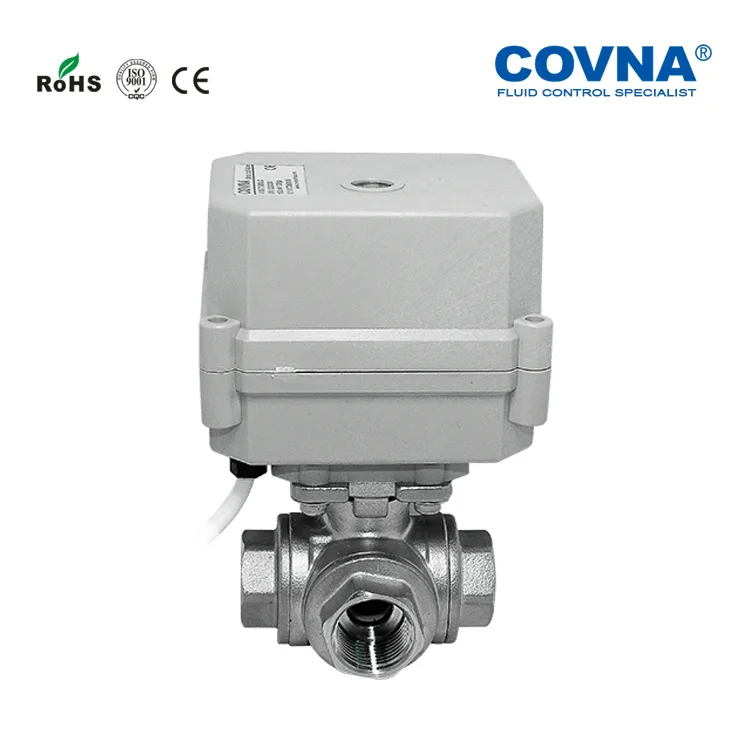

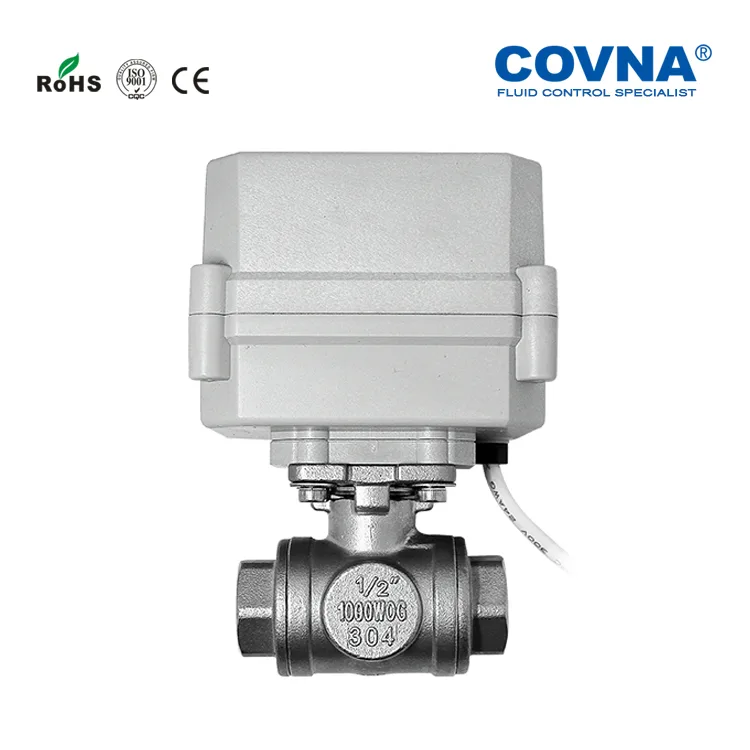
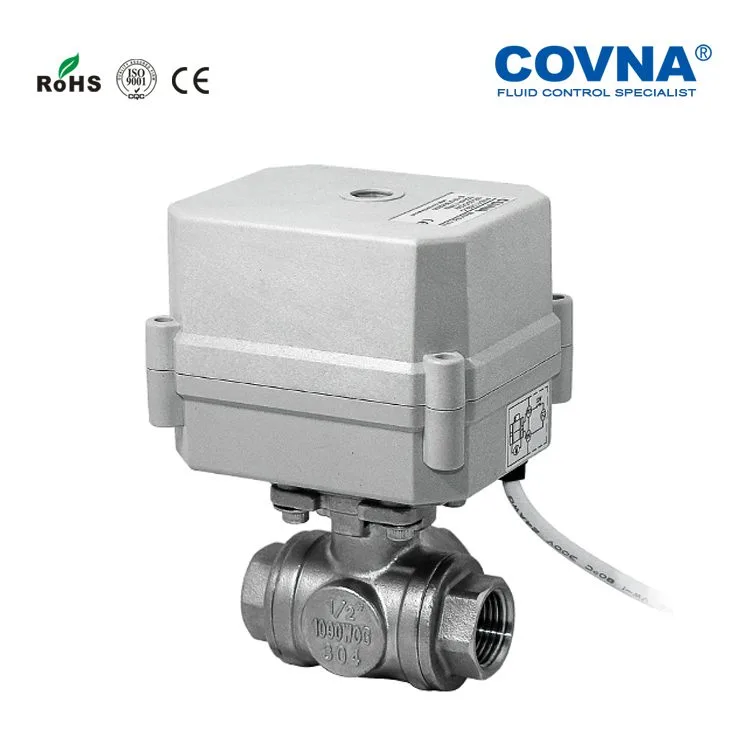


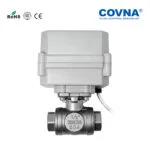
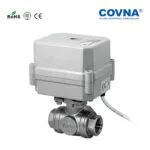
COVNA HK62-S-T Stainless Steel 3-Way Motorized Ball Valve
Stainless Steel 3-Way Motorized Ball Valve
widely used in automation equipment such as solar equipment, exhaust gas treatment system, fire protection system, irrigation system, etc. Suitable for water, oil, air, gas and other medium controls. Features including fail-safe, compact design, long working time.
As a motorized ball valve supplier, COVNA manufacturers 2 way or 3 way motorized ball valve in brass or stainless steel material for your choice to meet your requirements.
Consult us to get the right valve!
Model
- Body Material: Stainless Steel
- Max. Pressure: 10bar
- Liquid Temperature: 2 to 90℃
- Suitable Medium:Water, air, gas, etc
- Voltage: DC-12V, 24V; AC-24V, 120V, 240V/60Hz; 110V, 220V/50Hz
- Open/Close Times: ≤15S
What Is Miniature 3 Way Motorized Ball Valve?
Miniature 3-way motorized ball valve with features of compact design and energy efficiency. Miniature 3-way motorized ball valve means 3-way ball valve driven by a motorized ball valve actuator. Available in T port and L port to meet your diverter purpose.
COVNA miniature motorized three-way stainless steel ball valve provides you with a reliable fluid solution. Its advantage includes integrated design, which reduces the external volume, saves the installation space, and it is easy to operate and use. It helps you transport, shut off and change the direction of the medium. Widely used in automatic equipment such as flue gas sampling machines, air conditioning systems, building automation systems, and water treatment systems.
What’s more, miniature 3-way motorized ball valve available in brass and stainless steel material for your choice to meet your requirements
Features Of HK62-S-T Stainless Steel 3-Way Motorized Ball Valve:
● Full copper gear design, high precision and high torque output
● Compact design and structure
● Low operating current. The battery can act as a power source when power off to keep your project safe
● Good sealing performance and zero leakage. IP67 protection class for outdoor use
● Available in fail close type, fail open type, regulation type, manual override type and timer control type for your choice to meet your various needs.
Technical Parameters Of Miniature Stainless Steel Motorized Ball Valve:
| Port size | DN15, DN20,DN25 (Optional) | Medium | Water, air, oil, gas, etc |
| Ambient Temperature | -15 to 50℃ | Rated Voltage | DC-12V, 24V; AC-24V, 120V, 240V/60Hz; 110V, 220V/50Hz |
| Working Current | ≤800mA | Open/Close Time | ≤15S |
| Life Time | 70,000 Times | Actuator Material | Engineering Plastics |
| Torque Output | 10.0N.M | Liquid Temperature | 2 to 90℃ |
Dimension of HK62-S-T Stainless Steel 3-Way Motorized Ball Valve:

Packing:

Company Show:

Certificates:

1.Oil and Gas Industry
Pipeline Flow and Pressure Control: Used for flow and pressure control in natural gas and oil pipelines to ensure stability during transportation.
Gas and Liquid Distribution Systems: Regulates the flow of gases or liquids, ensuring precise control under various operating conditions.
Automation of Distribution Systems: Used in refineries and natural gas processing plants to automate fluid distribution and regulate the reaction processes.
2.Chemical and Petrochemical Industry
Reactor Pressure and Flow Control: Used in chemical reactors, storage tanks, and other equipment to control pressure and flow, ensuring stability in the chemical reaction process.
Flow/Pressure Regulation: Regulates the flow of liquids or gases in processes such as polymerization, refining, and distillation to ensure efficient production.
Steam Control: Regulates the flow and pressure of steam in steam generators and distribution systems.
3.Water and Wastewater Treatment
Water Flow Control: Regulates water flow and pressure in water supply and wastewater treatment systems to ensure normal operation.
Gas and Chemical Additions: Regulates the flow of chemicals or gases (such as chlorine or ammonia) added during the water treatment process.
4.HVAC (Heating, Ventilation, and Air Conditioning) Systems
Temperature Control and Airflow Regulation: Used in air conditioning systems to regulate the flow of cooling or heating fluids to maintain the desired temperature.
Pressure and Airflow Regulation: Adjusts the flow and pressure of air in ventilation, air conditioning, and humidification systems to ensure indoor comfort.
5.Food and Beverage Industry
Liquid Flow Control: Precisely controls the flow of liquids in processes such as brewing, dairy production, and beverage bottling.
Temperature and Pressure Regulation: Regulates temperature and pressure during heating, cooling, and sterilization to ensure product quality and safety.
6.Pharmaceutical Industry
Precision Flow Control: Regulates the flow of liquids and gases in pharmaceutical manufacturing processes to ensure precise control of process parameters.
Pressure Control: Adjusts pressure in cleaning and sterilization systems to ensure stable system operation.
7.HVAC Systems
Airflow and Temperature Control: Controls the flow and temperature of air to adjust environmental conditions, ensuring comfort and energy efficiency inside buildings.
8.Steel and Metallurgical Industry
Gas Flow Control: Precisely adjusts the flow of gases such as oxygen and nitrogen during smelting and heating processes to ensure stable furnace temperatures and chemical reactions.
Cooling Fluid Flow Regulation: Regulates the flow of cooling fluids in cooling systems to ensure temperature control of equipment.
9.Thermal and Power Industry
Steam and Water Flow and Pressure Control: Regulates the flow of steam and water in boiler systems, heat exchangers, and power plants to ensure efficient operation of thermal systems.
10.Mining Industry
Slurry Flow Regulation: Adjusts the flow and pressure of slurry during transportation and separation processes to ensure efficient extraction and processing of minerals.




